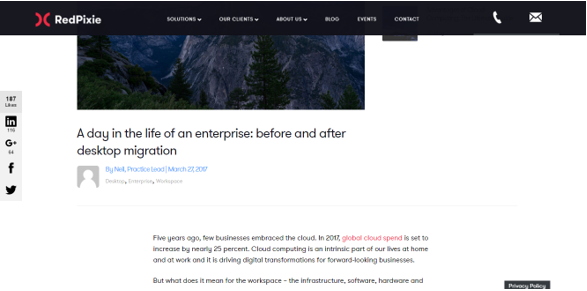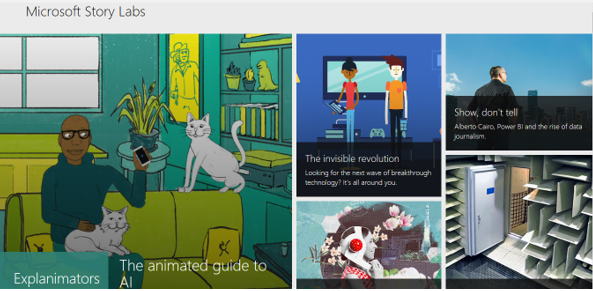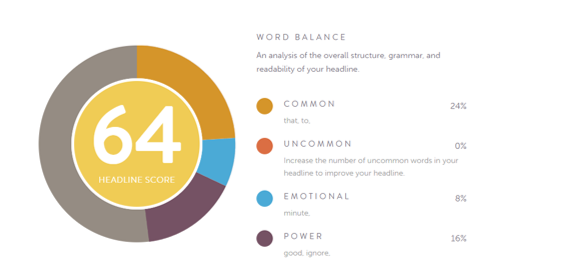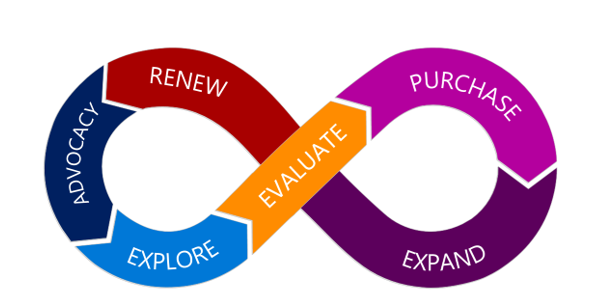5-minute guide to creating content that’s too good to ignore
There are 27,000,000 pieces of content shared every day. So, what can you do to ensure your blog, webinar or infographic is seen and shared by the right people?
Creating remarkable content is every marketer's goal, but to begin you need to know what the term 'remarkable' actually means. Content marketing isn't about building an archive of obvious sales pitches; it's about convincing your customers to take the next step in their relationship with your company.
Follow these simple steps to create content that turns casual visitors into die-hard evangelists.
Step 1: Get to know your audience

An example of targeted writing from Microsoft Partner, RedPixie.
Good content solves an issue or offers practical advice. Remarkable content explains exactly how your key demographic can overcome their biggest industry challenges. When it comes to content marketing, you need to fill in the gaps, not cover old ground.
The best way to do this is to understand exactly what makes your customers tick. Create buyer personas for every demographic you sell to, then tailor your content offers to these groups. For example, if your target audience is split between CIOs and CEOs, you would create separate personas based on their specific needs and challenges.
Once you've perfected these personas, you can narrow down the kind of content that is most appealing to them. There is a ton of different mediums to choose from. Here are just a few examples:
- Blog posts
- Videos
- Webinars
- Podcasts
- Thought leadership
- Case studies
- Reviews
- Analysis
All of these content types offer a different means of engaging your audience. Think about how they relate to specific stages of the buyer's journey and build your content marketing strategy around this funnel. Are they exploring potential solutions, making a final selection or somewhere in between?
Step 2: Create content that makes a difference

Now you've segmented your audience into their appropriate personas, it's time to begin creating your remarkable content. While truly thought-provoking content relies on your own intuition and flair, there are a few best practices every Partner can follow:
1. Be original. There is nothing worse than generic, repetitive content. Use your buyer personas to tailor each asset towards a specific audience, addressing topics from a new perspective and unique voice.
2. Don't be too partisan. Even if you naturally come down on one side of the argument, try to create a well-balanced account. 41% of IT decision-makers say they're wary of hype and exaggeration, so cut it from your work.
3. Stay relevant. Ensure all content is up to date. Incomplete or inconsistent content irritates 31% of IT decision makers, because it is unlikely to be accurate.
4. Master timing. Good timing is crucial. Don't offer a product demo to someone who has only just discovered your company website. Stay mindful of personas and which stage of the buyer's journey you are producing content for.
Check out this HubSpot list of companies exceling at content marketing (including Microsoft's own blog Microsoft Story Labs).
Get a head start

Great headlines and subheadings make all the difference. On average, visitors only read 20% of a web page, so your content needs to remain scannable and easy to digest. Keep headers between 50-65 characters and ten words or less. The easier it is to pick out key information from your content, the more likely it is that visitors will stay until the end.
The content of your headers is also important. Use a tool like CoSchedule's Headline Analyser to create the perfect, attention-grabbing headlines.
Step 3: Optimise and audit your content

Get your content seen
Content marketing doesn't end at its creation. How you optimise and analyse your content will ultimately determine its success. With so much content available to potential prospects, you need to write with online visibility in mind. After all, what use is great content if no one sees it?
Search Engine Optimisation (SEO) puts your work in the places customers are looking for it and ensures you're answering their specific queries at each stage of the buyer's journey. While we won't go into optimisation in great detail here, you can find out more about it in our previous 5-minute guide to improving your SEO.
Learn from your successes and mistakes
Strong marketing relies on effective post-mortems. A content audit helps you decide how to approach your content strategies in the future. Take a look at your current content collection and ask yourself a few simple questions:
- Which content has been most successful?
- Why has it been so well-received?
- Which stage of the buyer's journey does it benefit the most?
Doing this for each piece of content you create enables you to note its specific marketing value and build a sales funnel that puts the customer first.
Atomise your best content
Atomising content means recycling it in a number of novel ways such as infographics, shorter blog posts, or LinkedIn posts. The aim is to take a longer piece of 'hero' content and repurpose it to deliver fresh and engaging points of view. Smaller pieces of content are easier to market and can link back to the original post for maximum exposure.
Writing and drawing your own conclusions
In this article, we've offered you a template for creating remarkable content. But your own expertise and imagination will ultimately decide its fate.
Remember: content that is accurate, unbiased, relevant and well-timed is a great place to start. Combining these basics with a unique voice and perspective will help your content stand out in an avalanche of marketing spiel.
For more information on creating customer-centric content, check out our Microsoft Partner Transformation Toolkit.